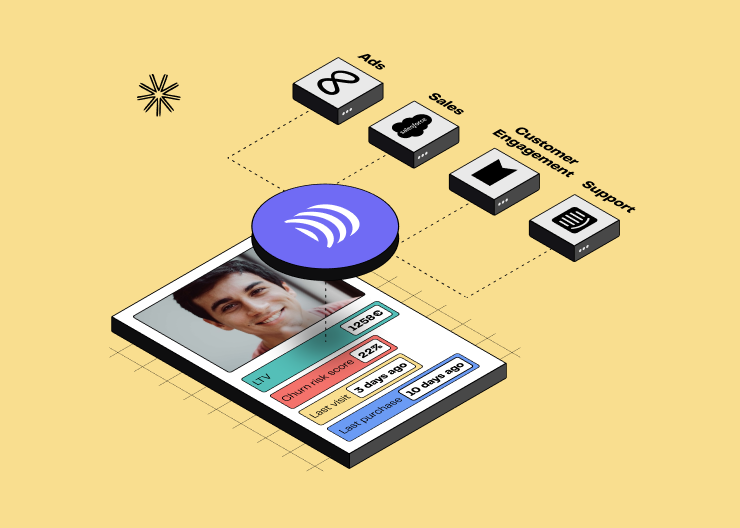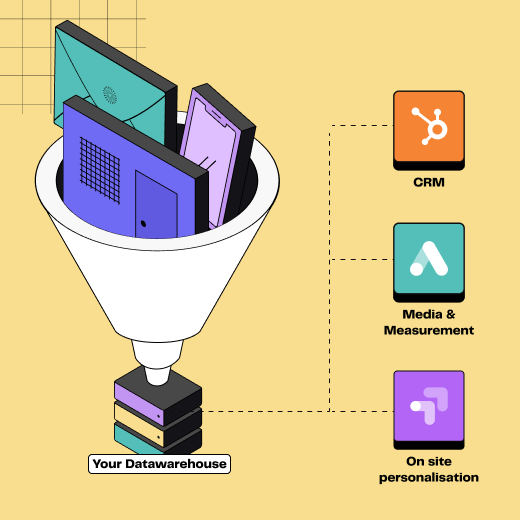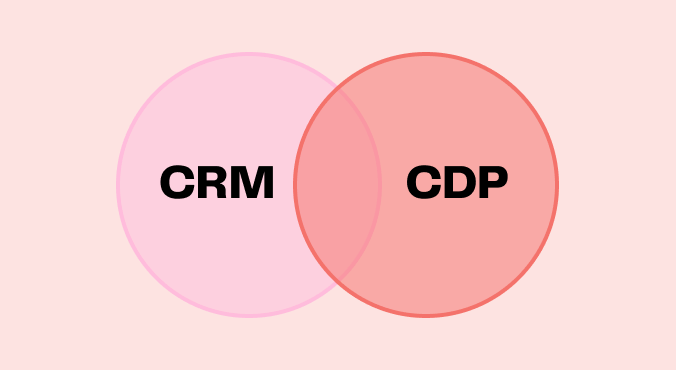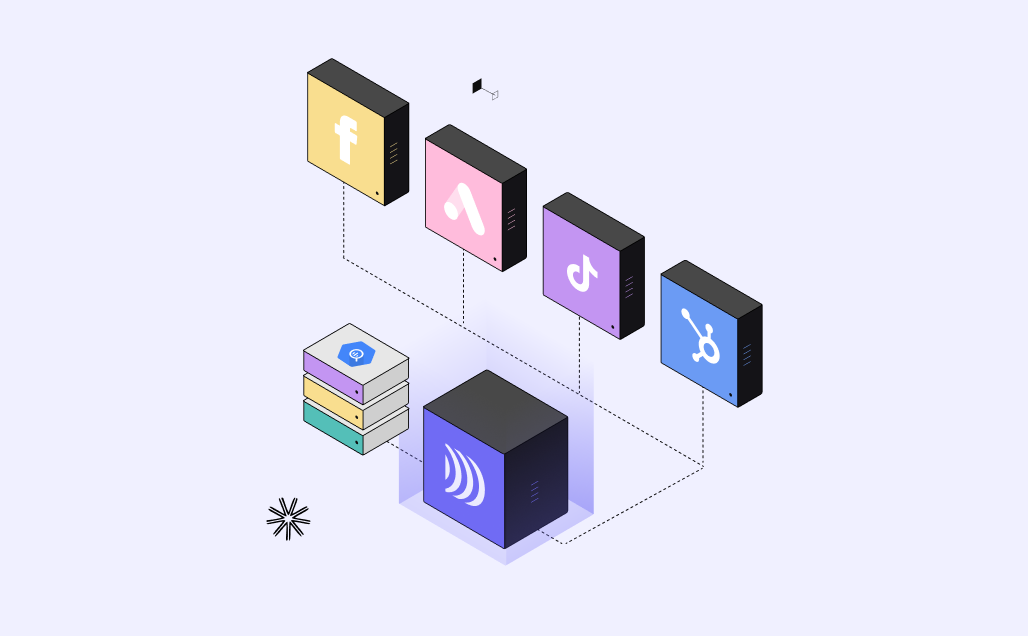A Customer Data Platform (CDP) is a packaged software designed to create a comprehensive 360° customer database for tracking, analyzing, and managing customer (or prospect) interactions.
The purpose of a CDP is to collect and aggregate data from various sources, sort it (especially from a GDPR perspective), segment it, and activate it across different platforms.
This guide summarizes everything you need to know about Customer Data Platforms: a brief history, definition, types of managed data, use cases, benefits, and selection criteria.
Brief History of CDPs
Platforms for managing customer data have been in existence for a while, but they have significantly evolved over time.
1. CRM
In the early 1990s, businesses used Customer Relationship Management (CRM) systems to store customer data. These systems were designed to manage relationships and interactions between companies and their customers and prospects. They help companies stay connected and streamline and automate their processes.
While CRMs are still used today, especially by sales and customer success teams, they have several limitations, including:
Management of first-party data only
No centralized data from multiple channels (online and offline)
Focus solely on sales and customer support, lacking data activation on conventional marketing platforms
Main differences between CRM and CDP are longer explained in our dedicated article.
2. DMP
In the early 2000s, businesses started using Data Management Platforms (DMPs) to collect customer data for online advertising. These platforms primarily rely on third-party cookies to gather information about unknown audiences (those not yet customers of the brand). Unfortunately, they are not effective in managing known data (from existing customers) or storing data over extended periods.
In summary, DMPs have limitations compared to CDPs:
Management of third-party data only
No 360° view of a customer
Focus solely on advertising
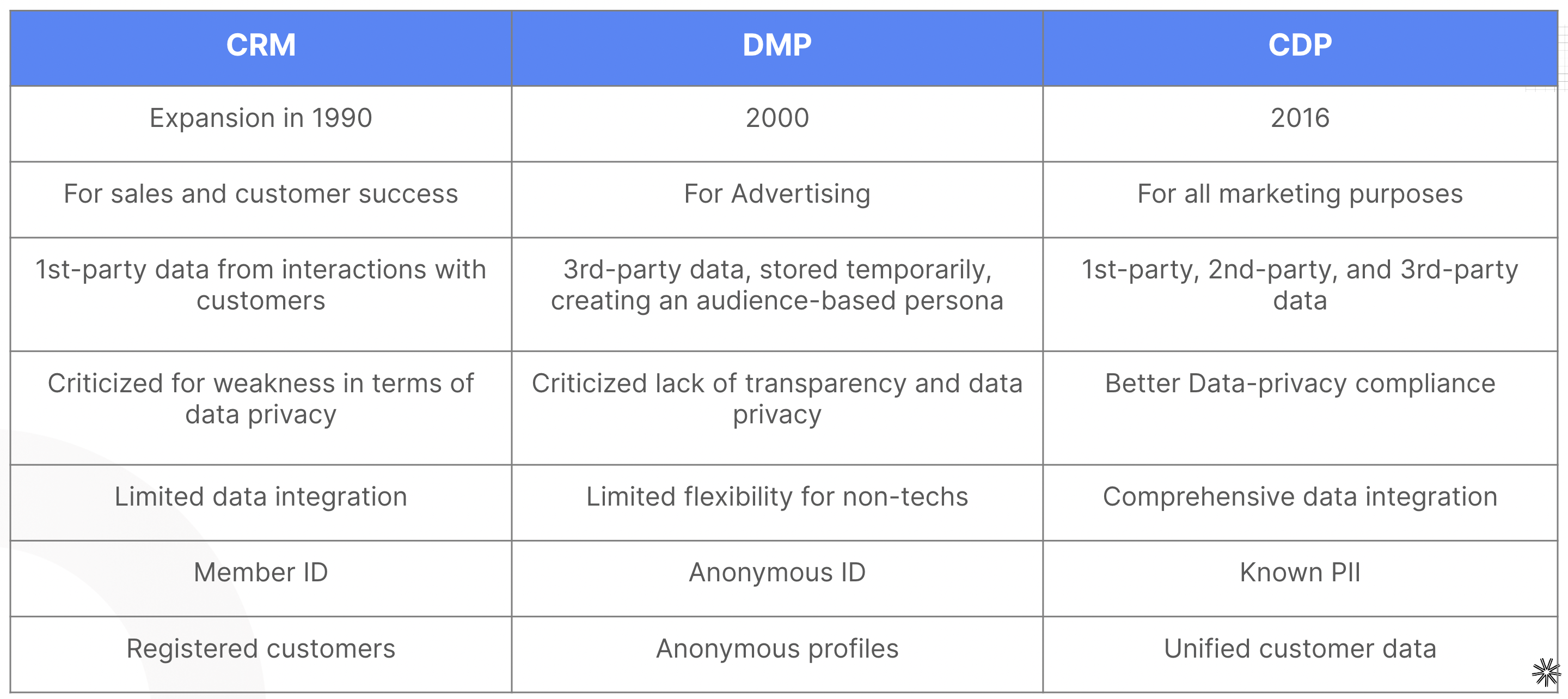
CRM vs CDP vs DMP
What is a CDP?
Over the years, the digital customer journey has become more complex, with increasing touch points. To address this challenge, CRM and DMP-type tools attempted to reinvent themselves: some CRM providers created connectors with major media activation tools, and some DMPs began including first-party data.
Additionally, Tag Management Systems (TMS) emerged, allowing the collection of online events. These TMS can then be connected to third-party platforms to collect all this data.
In 2013, David Raab, a marketing technology consultant, noticed the emergence of a new type of tool. He coined the term CDP in a blog post:
CDP: Packaged software that collects and organizes customer data from multiple sources - such as websites, mobile apps, social media, emails, offline interactions - into a unified database. David Raab
The chosen name for this platform is intentional and clearly defines its purpose:
"Customer": Covers all functions related to the customer: marketing, sales, support, customer success, CRM, etc.
"Data": Emphasizes the importance of data, from collection to activation.
"Platform": The CDP is not only for managing data but also supports other systems.
Since 2013, interest in CDPs has greatly increased, and the topic remains relevant in 2024.
💡 Although the explosion of the "martech" landscape from 2013 to 2020 closely associated them with marketing use cases, the scope of CDPs extends to all customer-related functions (sales, support, CRM, etc. - and obviously marketing).
What Does a CDP Do?
Overall, a Customer Data Platform serves three main objectives.
1. Collect and Centralize Data
Customer data can be scattered across various locations: websites, analytics, emails, CRM, mobile apps, social media, offline interactions, etc. Business "siloed" systems operate independently without associating data. Each operates with its own data, without having a 360° view of the customer journey. This can lead to inconsistent customer experiences.
The goal of Customer 360 (included in the CDP) is to eliminate these limitations by connecting all tools and acting as a single source of truth for proprietary customer data (all while normalizing it).
💡 Increasingly, companies are investing in a data warehouse to embody this Customer 360. This new approach has fostered the emergence of composable CDPs, detailed later in the guide.
2. Data Management: Transformation, Modeling, Segmentation
Customer Data Platforms allow the management of data, including:
Transformation and aggregation, often facilitated by Extract, Transform, Load (ETL) processes
Modeling, including enrichment through statistical models, data science, or artificial intelligence (e.g., calculating Lifetime Values, churn probabilities, etc.)
Segmentation into relevant "blocks" (consumer profiles, transactions, product interactions, etc.)
💡 Customer segmentation is crucial for addressing the right person at the right time on the right channel.
3. Activate Your Data
This crucial step involves synchronizing segmented data with business tools so that they can be used (e.g., for audience strategies).
Reverse ETL tools have specialized in this specific step, enabling the sending of all data to third-party platforms.
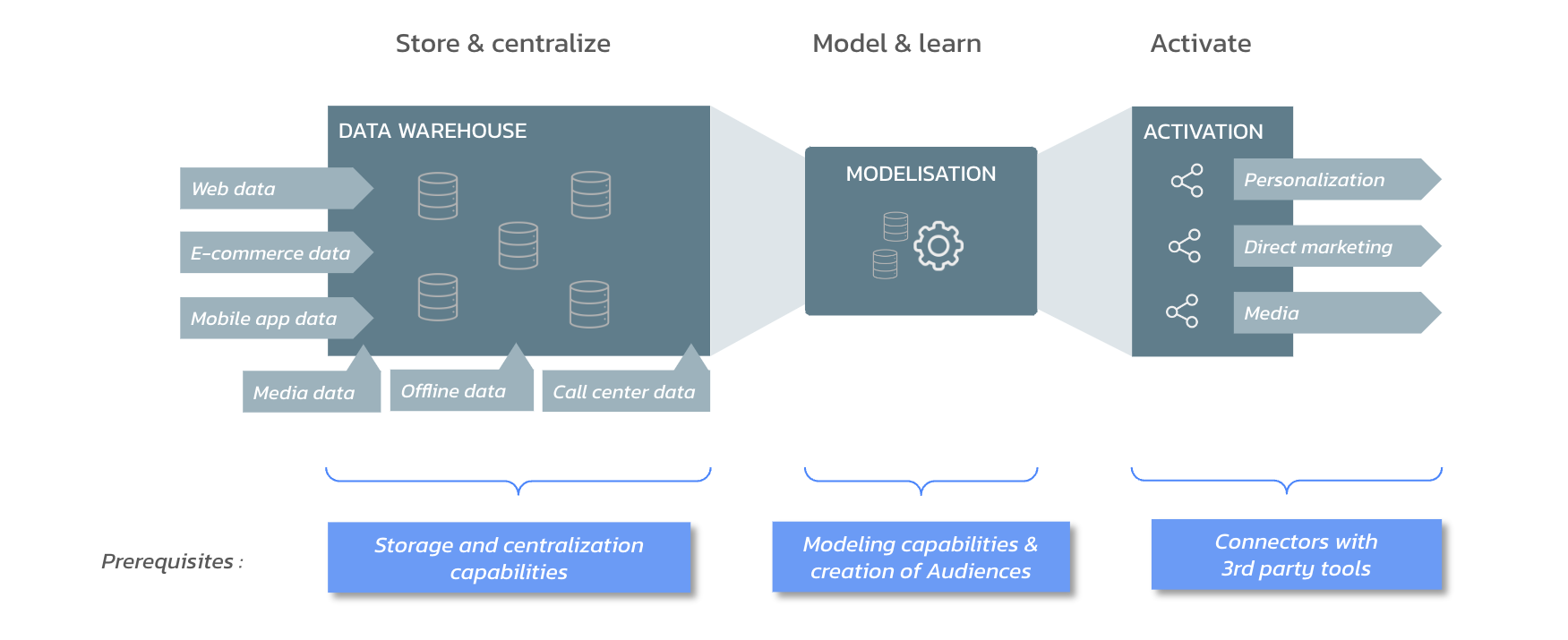
Schematic diagram of a CDP
Other solutions can also assist with activation issues but may not necessarily address centralization and segmentation challenges.
What Data is Used in CDPs?
A Customer Data Platform collects various types of data to create a 360° view of customers that can be activated across all platforms. Data includes information that individuals leave during their online navigation, in-store interactions, or phone calls, for example.
Each tool can enrich the information already possessed by another tool. While CRM generally centralizes the most information about a person's identity, this information is also useful elsewhere.
The CDP can centralize all types of data: first-party, second-party, and third-party data.
The most frequently centralized and activated data in CDPs include:
Profile Data
This includes data related to a customer's identity: name, first name, email address, age, phone number, etc.
Having maximum information about customers has several advantages, including better personalization of communications and a higher matching rate in third-party tools.
Behavioral Data
Behavioral data is essential for understanding how an individual interacts with your brand. This helps understand what they really seek and the best way to communicate with them (via phone, email, etc.).
These data encompass:
Interactions with customer service
Clicks, page views, events on the website
Email open rates
Transactional Data
Transaction-related data allows tracking the purchase history and understanding buying behavior (frequency, seasonality, promotion-related incentives, etc.). This helps identify various buyer groups: big spenders, people who spend little but frequently, people who frequently return their orders, etc.
Product Data
Some CDPs can also centralize product data, even though this is more related to a company than to customers. It allows real-time knowledge of product stock levels (for each model, size, color, etc.).
Advantages of a CDP
A Customer Data Platform allows the implementation of several use cases and frees up time for the teams using it.
Consolidation of Customer Data: It may be repetitive compared to the rest of this article, but the number 1 advantage of a CDP is relying on a "single source of truth," providing a holistic and unified view of the customer from multiple sources.
Personalization of Customer Experiences: From consolidated data, you can further personalize customer experiences based on purchasing behaviors, product preferences, etc.
Advanced Segmentation: The CDP enables the creation of more precise and sophisticated segments, usually without coding, facilitating campaign personalization. Better segmentation, combined with effective audience strategies, increases the conversion rate.
Optimization of the Customer Journey: Analyzing customer data by the CDP identifies the most effective touch points (and the right moments) throughout the customer journey, contributing to optimizing overall business performance.
Compliance and Privacy Respect: CDPs help companies comply with data protection regulations (CNIL and GDPR) by managing consents.
Improved Customer Loyalty: By offering more personalized and relevant experiences, companies can strengthen customer loyalty and increase retention.
Informed Decision-Making: CDPs offer advanced analytics and reporting tools based on real-time data, allowing companies to understand their results and adjust their actions accordingly.
Limitations of Traditional CDPs
Like all tools, traditional CDPs (in the format existing since 2013) have several limitations today:
Implementation Complexity: A "classic" CDP project can sometimes take more than a year to land. Implementation is often complex and requires significant IT resources to build interfaces with other systems. Additionally, data models are rigid, forcing companies to rethink their data organization.
Cost: The entry ticket for traditional CDP licenses is over 100,000 euros. Some licenses, for larger companies, can even reach a million! Yet, operating costs are also high.
Data Security: A traditional CDP stores your data. This raises governance questions, exacerbated by their functioning as a "black box."
For these reasons (and others!), new Composable CDP solutions are emerging in the market, especially with the advent of Reverse ETL.

Data Activation
How to Choose a CDP?
To succeed in your CDP project, here are 5 steps we recommend you follow:
Define Your Needs, Use Cases, and Objectives: Your CDP should be able to integrate with all your tools and enable the use cases that are important to you. Especially, keep in mind your current and future needs, particularly from a destination perspective.
Define Your Criteria in Terms of Data Hosting: With a traditional solution, your data will be in the hands of the CDP vendor. In contrast, with Cloud or On-premises hosting (Composable CDP), you retain control over your data. Discuss this with your legal teams to determine the most suitable solution for your company.
Ensure the Solution is Easy to Use and Meets Your Needs: Otherwise, it will never be used by end-users. According to a Forrester report, only 11% of companies are fully satisfied with their current CDP. Don't make this mistake; it could cost you dearly.
Ensure the Solution is Easy to Deploy: Particularly, it should not require a complete upheaval of the current IT organization. If you have identified the CDP as a solution to your problems, it is urgent for you to implement it - or at least find a temporary solution to implement the first use cases. However, traditional CDPs often take several months (or even years) to implement.
Identify and Measure Any Additional Criteria Specific to Your Company
Conclusion
At DinMo, we remain convinced that activating your data is key to performing in a challenging economic context. If you want to discuss CDPs in general or our modular approach, let's have a coffee ☕️ to delve deeper.












